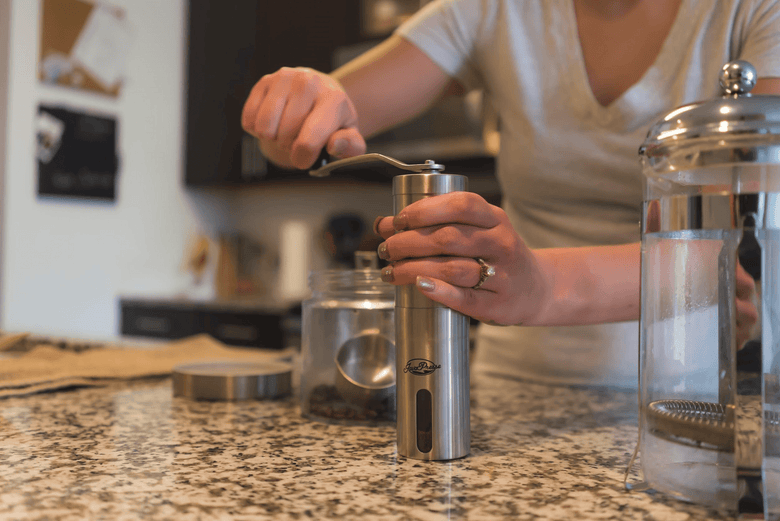Have you ever bought beans from a coffee shop and asked the barista to grind the whole bag for you? I understand, we’ve all done it, but it’s a mistake every time.
Coffee freshness doesn’t stick around forever. In most scenarios, you only have 2-3 weeks once the coffee is roasted to experience it at peak freshness and flavor. For ground coffee, it only takes 30 minutes to reach the point where freshness declines rapidly and noticeably.
If you want fresh, flavorful, balanced coffee that’s blow-your-mind good, you won’t find it by batch grinding coffee bags. The solution isn’t difficult and only slightly less convenient - but the results are dramatic.
My goal is to empower you to brew coffee that adds color to your day, coffee that gives you the satisfaction of creating something delicious by your own hand. Batch coffee grinding keeps these things away from us, so let’s get honest about why you should never do that.
Read: Why Your Grinder Is The Most Important Piece of Coffee Gear
Batch-Grinding Is A Quick Way To Kill Your Coffee
Counter to what some coffee companies want you to believe, coffee goes stale rather quickly. These deceptive companies sell pre-ground coffee by a “best by” date far in the future. This is - to be frank - a dirty lie that robs you of experiencing rich and delicious coffee with that fresh zing.
Coffee is never “best by” 2 months down the road - or 6 for that matter. Ask any coffee professional, researcher, or food scientist and they’ll tell you the same thing: coffee is best 2-3 weeks after it’s roasted. Any other claim can mostly be traced to a marketing campaign, but not an intimate connection to the coffee.
To buy and brew stellar coffee, you need to be able to see through these lies.
Read: How To Read Coffee Packaging Like A Pro
Oxygen Isn’t A Friend Of Coffee
One of the main reasons coffee only has 2-3 weeks of peak freshness once they’re out of the roaster is the decaying quality of our good friend, oxygen. Except oxygen isn’t a friend of coffee.
Oxygen is one of the great decayers. Through a process called oxidation, metals rust, apples brown, fires burn bright, and food is digested. The destructive nature of oxygen affects our coffee as well.
Oxidation causes the coffee acids to break down, encourages the aromatic oils to evaporate, and compromises the coffee cell structures. When it’s all said and done, your coffee is only a shadow of its former self.
The vibrant flavors have devolved into a indistinguishable muddiness. The rich aromatics have evaporated away. The crisp, refreshing acids have broken down into an abrasive tanginess. Bitterness has risen from the ashes of the incredible flavors.
This inevitable decay of freshness and flavor happens much more quickly in coffee grounds than whole beans largely because it simply takes longer for oxygen to penetrate large particles than it does smaller particles.
Read: Why You Shouldn't Freeze Your Coffee Beans
You Never Win With Batch Grinding
Batch grinding coffee takes large, oxygen-resistant beans and turns them into tiny grounds. All of these grounds are now more exposed than they were since you had to open the bag to grind them, but there’s still hope for the grounds at the bottom of the bag where oxygen cannot easily get. However, by the time you get to them, they won’t be fresh at all. Here’s why:
The top layer of coffee (the most exposed) has only 20-30 minutes of peak freshness once its ground. The lower levels are less exposed to oxygen and have quite a bit longer of peak freshness. However, these lower levels are continually exposed to more and more oxygen as you use your coffee, even if you follow coffee storage best practices.
So while the coffee half way down may be relatively fresh now, by the time you’ve used the grounds above that point, they won’t be. Here’s how it works:
- You scoop out grounds from the top layer of coffee. If you just ground the coffee, these grounds may still be at peak freshness.
- The next day, you scoop out grounds for the top layer. By now, these top grounds are stale, but the layer immediately under still has some freshness to it.
- The third day, you scoop out grounds from the top layer. Though they were somewhat fresh yesterday when they were covered by other grounds, they’ve now been exposed for some time and are completely stale.
This is why you never win with batch coffee grinding. As you use the bag, you kill the only remaining freshness in a never-ending cycles.
But there’s hope for you yet.
Read: Have You Tasted These 11 Common Coffee Flavor Defects?
A Home Coffee Grinder Is The Only Solution
Like I said, I understand how convenient it can be to have already-ground coffee. But there’s no substitute for freshly ground coffee. Not by a long shot.
Having a burr grinder at home enables you to grind your beans right before you use them. By keeping those beans whole, you spare them from the horrifying flavor death of oxidation, which preserves their fresh qualities and flavor.
Our mission is to empower you to live life with focus, intention, and purpose - and gross, dull, stale coffee doesn’t accomplish this well.
To combat the ineffectiveness of stale coffee, we’ve developed our own JavaPresse Manual Burr Grinder...
It’s light, affordable, and very powerful. With it, you’ll feel the satisfaction of incredibly delicious coffee and you’ll be able to use any coffee brewer you want.



